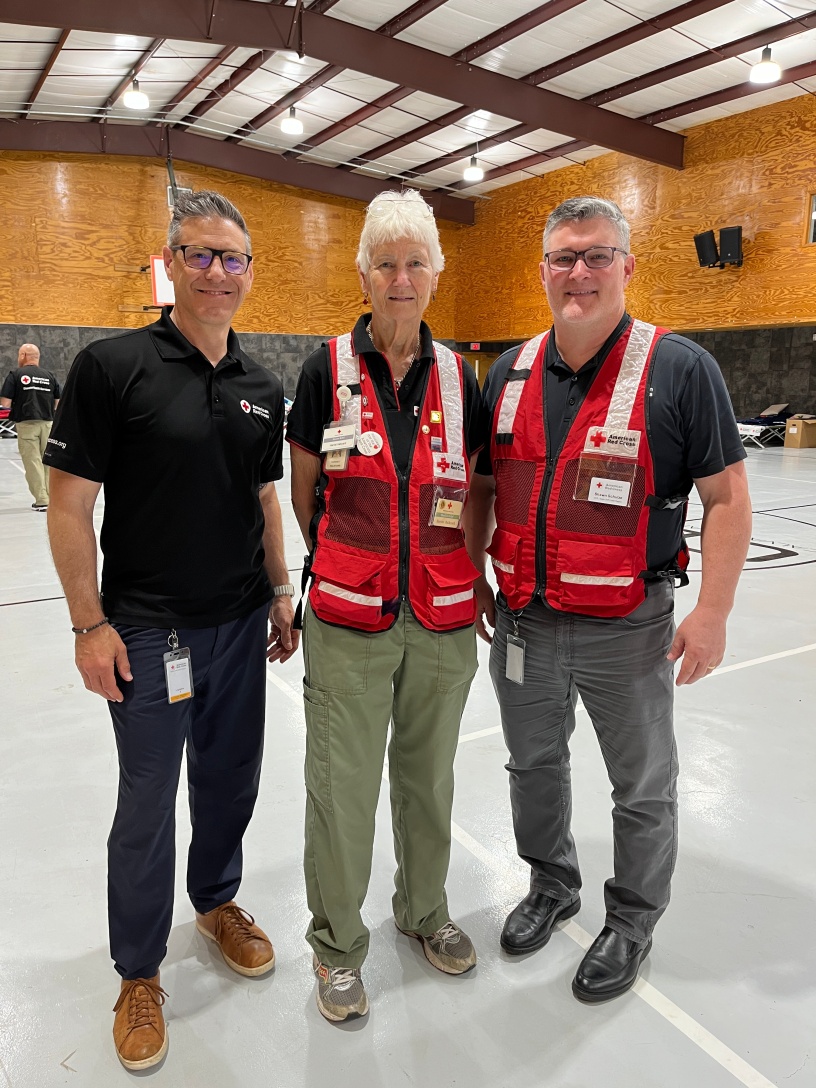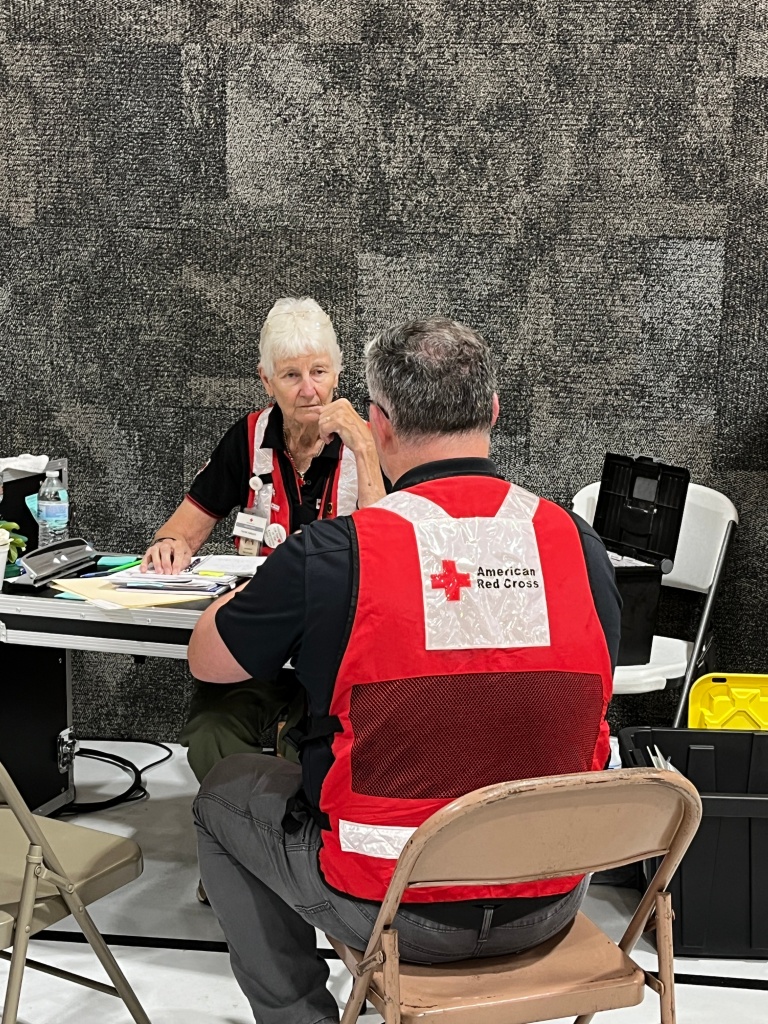On January 17, 1994, at 4:31 a.m., the ground violently shook underneath Northridge, California. According to the California Department of Conservation, the earthquake caused over 60 fatalities and injured thousands. The property damage and economic loss were staggering. It is the costliest earthquake disaster on record.
“I was living in San Diego when I heard about the Northridge earthquake. I wanted to help,” said Harriet Halkyard. Not long after the earthquake, she joined the American Red Cross. Now, 30 years later, she is still on the job.
Born and raised in England, Harriet Halkyard’s path led to New South Wales, Australia Where She lectured in voice and speech training for the National Institute of Dramatic Arts there. Her voice is delightfully clear. “I speak BBC English. My parents paid a lot of money for it,” she chuckled. “I speak English. Everybody else around here speaks American.”
A turn of events ultimately led Harriet Halkyard to San Diego where a chance meeting led to marriage. Harriet’s husband works in the offshore mining industry. Her husband was traveling to Texas every week for work. “My husband asked if I would mind moving to Houston for two or three years. I said heck no. Texas has so many more disasters. I wanted to develop my Red Cross career. In California, they were ready for the big earthquake, but at that time, nothing was happening. Single-family fires were it. I’ve done my share of Red Cross Disaster Action Team work (DAT).”
DAT is one of the many opportunities the Red Cross has for people to serve. The DAT volunteers are the Red Cross first responders. They help victims of incidents like house fires.
Harriet continued, “I came to Houston, and oh yes, there were many more disasters here. My career went forward in leaps and bounds.” Twenty-three years later, she still lives here.
Harriett’s most recent assignment was as a shelter manager in the outskirts of Houston in an area hard hit by flooding. When asked how long the shelter would be open, she shot back. “Can you tell me when the water will go down? The shelter is open now and will stay open until everyone has somewhere safe and dry to go.” That answer reflects who Harriet is. It is a testament to her commitment to serve others in need.
Having served in multiple capacities, Harriet has often deployed to disaster areas. “I have been in about 60 national volunteer deployments so far,” she said. “My first was the Red River Flood up in the Dakotas. You may have to stay about three weeks on each deployment, which I like. It gives me more of an opportunity to get somebody through their problems. Two weeks, hardly enough time. I like the longer deployments because you get to know the community and what’s going on. The people are not there from day one to day 21. On day five, somebody comes in. On day 10, somebody else comes in. And you help those through.”
As a volunteer, you need to be prepared. Harriet said, “I’ve learned that wherever I go, I always take at least one granola bar and one bottle of water with me. I have worked in damage assessment, casework, public affairs, fundraising, and more. I’ve done a little bit of a lot of things. I was a level III job director.”
The Red Cross has recognized Harriet for her work multiple times. In 1999, she was presented with the National Disaster Volunteer of the Year Award. She has also received other accolades in Texas and California.
The experience of volunteering for the Red Cross can be very rewarding. “The other day, one of our clients came up and talked to a group of us who were discussing something. Harriet related his comments,” You know, we come in here. We are so down. We’ve lost everything. And we don’t know what to do. And then you Red Crossers come in and smile. And are up! And you don’t look down on us. You are looking at us as people, and you bring up our spirits Harriet said. “That paraphrased what he said, but it was really nice.”
Again, on another deployment Harriet remembers, “I was in a warming center in Houston a couple of years ago,” Harriet said. “Somebody wrote a letter. It was mostly homeless people in that center. They wrote a note that came back to me. It said how nice it was that the Red Cross treated us homeless folks as equals and helped us as they would family.”
“In Louisiana a few years ago, a tropical storm wiped out a load of people,” Harriet said. “I was sent in to run a service center. It was to open at 9 a.m., and I thought the staff should be there at 8 a.m., so I thought I would arrive before them. When I arrived at 7 a.m., the line literally wrapped around the building, people 4 to five deep all around the building. I went in, briefed the staff, and then came out and talked my way down the line. I gave people appointments to come back, 1 p.m., 2 p.m., 3 p.m. and so on.”
Harriet continued, “And again, people were so grateful. One of the staff came to me afterward and said, you know, one of the clients thanked me for being here. And that is a rare thing. They all think we work here, and we’re paid. They don’t realize we’re volunteers. So I put up signs in the room saying, Charlie from Tennessee. Mary from Washington, or wherever it was. So clients could see that all these people had come from different parts of America.”
When asked what she would say to someone interested in volunteering for the Red Cross, Harriet said: “I would ask if they were prepared to spend a few hours getting some training to help somebody in desperate need. It’s so easy to do. In fact, I’m planning to do it.”
“I want to come back to all these churches and train the congregation, continued Harriet, so when the whistle blows, and it’s going to happen again, we all know the congregation can stand up and operate their own facility. And have somebody trained in all aspects of mass care. That way, they will have a ready-made shelter. I’m planning on doing that shortly.”
Harriet is passionate about teaching others. “Commit one afternoon, and I’ll teach you how to run a shelter.” In talking about her current assignment, she said, “You don’t need a lot of people to run one. We have 63 people and two showers. We set a schedule. What time do you want to shower? A lot of people are not going to work. Their work is destroyed. They can take showers in the middle of the day. Some in the morning, some in the evening. You can put up a sign-up sheet in the shower. Women between 7-10 p.m., men between such and such, and work it out beyond that.”
People are needed as volunteers in all capacities. “We need people who know the area and will drive around. They can tell us how many houses are destroyed, affected, or unaffected so we know where to send our staff. Where people are and what kind of help they need. That is damage assessment,” Harriet said. “Then we have the shelter where everybody has somewhere dry and safe to stay, and they get food. This is mass care, handling multitudes of people. When that is under control, we bring in case workers and individuals to talk to families about what they need to get back on their feet. And working heavily with our partners and what the partners can do.”
“The church here, for example, the people keep coming into the shelter saying, what do you need?” Harriet shared. “Well, I have a gentleman who needs size 13 shoes. Another guy needs size 11, and his wife needs size 9, because these people walked through mud and lost their shoes. And the next day, brand-new shoes arrive. People are always asking what they can do. People in this area in Cleveland are going out and fulfilling that need. Bring in new blankets and towels so we can look after the people. It’s fantastic.”
“If people can’t spend the time working because they have jobs, then perhaps they’re the guys that can make the donations of money to Red Cross disaster services. Or they can bring in the towels and the shoes people need,” Harriet said. “If you can’t volunteer your time, please donate money. In general, it is much better than donating food or clothing. The Red Cross must be able to give everyone exactly the same thing. If we are buying food, we can buy it in bulk. Give us the money so we can let people buy their own shoes and things.”
An interesting side note that Harriet shared about volunteering for the Red Cross was about a group called DOVES. It is an acronym that stands for Disaster Operations Volunteer Escapees. They made an agreement with the Red Cross. Volunteers can deploy with their motorhomes. “We have an old motorhome which we have driven to disasters,” she said. “You can plug in behind where you have been working and go ‘home’ for lunch.”
If someone wants to become a Red Cross volunteer Harriet said all they need is, “An open heart, understanding, and being prepared to get your hands dirty. You’re going to be putting up the cots, moving people, and doing dirty jobs. You have to put yourself out.”
A Red Cross volunteers work sometimes comes with unexpected benefits. Harriet shared an example. “You could be walking through a Red Cross shelter or service delivery site. And somebody comes up to you and says, ‘Hey you!’ And you catch their eyes, and they throw their arms around you and say, ‘Thank you, you saved us!’ And that’s a really big plus. That’s what we do it for.”
Ninety percent of the Red Cross workforce consists of volunteers. Harriet pointed out, “It helps tremendously for people to know they are not alone in their time of need.” To find out more information on becoming a Red Cross volunteer, like Harriet, go to redcross.org/volunteer.
Story By: Francisco Philibert



